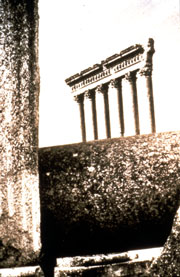Sophie Ristelhueber's installations, based on photographic images, reveal a profound questioning of the essence of the medium. This mid-career survey organized by the Museum of Fine Arts, Boston, illuminates the artist's attention to landscape as a manifestation of memory, with images of areas reeling from recent physical conflict, including 1984 Beirut and 1992 Kuwait. Her photographs, presented in series sometimes arranged from floor to ceiling, reveal her keen sensitivity to formal elements within compositions capturing the frightening beauty found in a scarred landscape-- or a human body. Although individual series have been exhibited in this country, this will be the first in-depth presentation of her work.

La Campagne (Countryside), 1997.
Digital color prints mounted on aluminum.
Courtesy the artist and the Galerie Arlogos, Paris.
Among the other works revealing the breadth of Ristelhueber's conceptual vision included in the exhibition will be examples from Vulaines (1989), in which the uneasiness of childhood memories and family dynamics are suggested in the details of domestic furnishings reproduced in life size, and an addition to her ongoing series L'air est à tout le monde. She is also completing a piece for this exhibition: Iraq (2001) will include images taken in an area that has intrigued Ristelhueber--Mesopotamia, one of the cradles of civilization. As in other pieces, she continues to address the futility in establishing boundaries as they are revealed throughout history.

Fait (Fact), 1992. Courtesy the artist and Galerie Arlogos,
Paris.
Conceptually and visually compelling, the photographs and installations of Sophie Ristelhueber address the essence of our existence as individuals and as a civilization in a voice that is both disquieting and, paradoxically, reassuring.
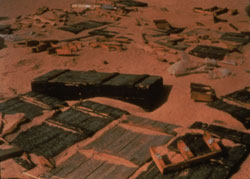
Fait (Fact), 1992.
Courtesy the artist and Galerie Arlogos, Paris.
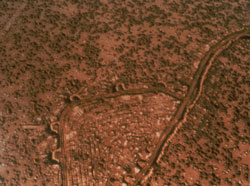
Fait (Fact), 1992.
Courtesy the artist and Galerie Arlogos, Paris.
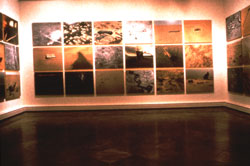
Fait (Fact), 1992. Installation View.
Courtesy the artist and Galerie Arlogos, Paris.
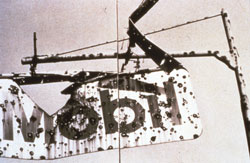
Beyrouth, Photographes
(Beyrouth , Photographs), 1984.
Courtesy Galerie Arlogos.
![]()
Museum
of Fine Arts
Boston Avenue of the Arts
465 Huntington Avenue Boston
Massachusetts 02115-5523
Tel. (617) 267-9300
